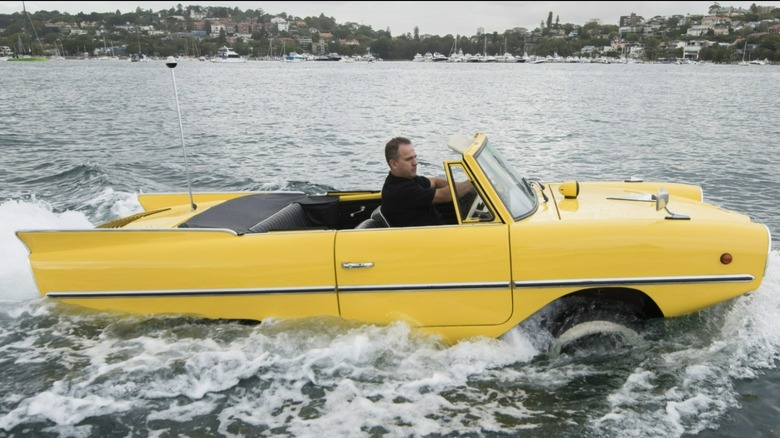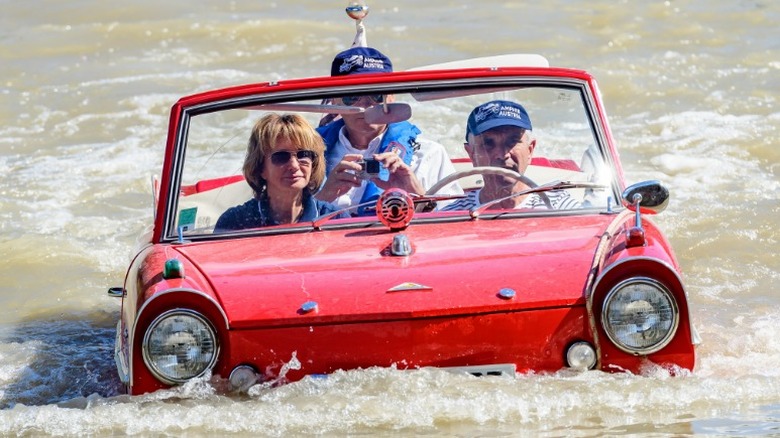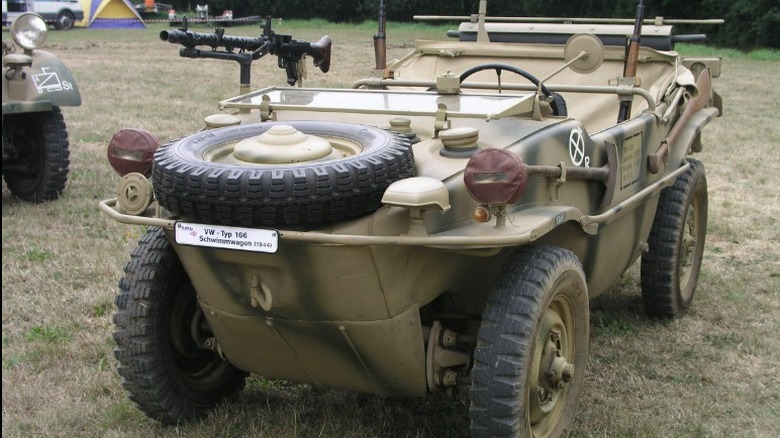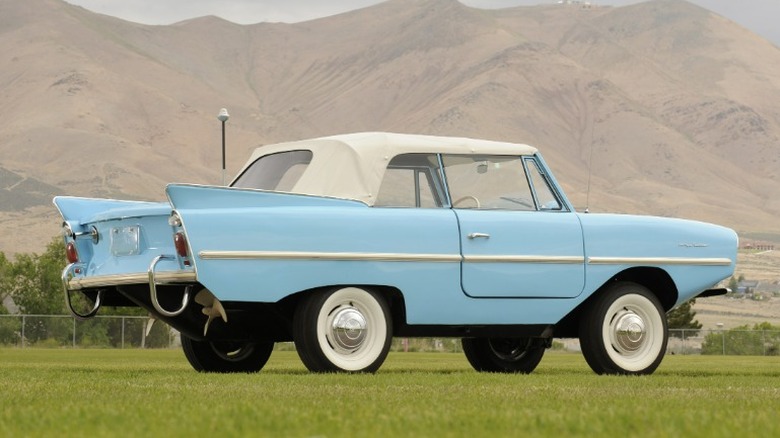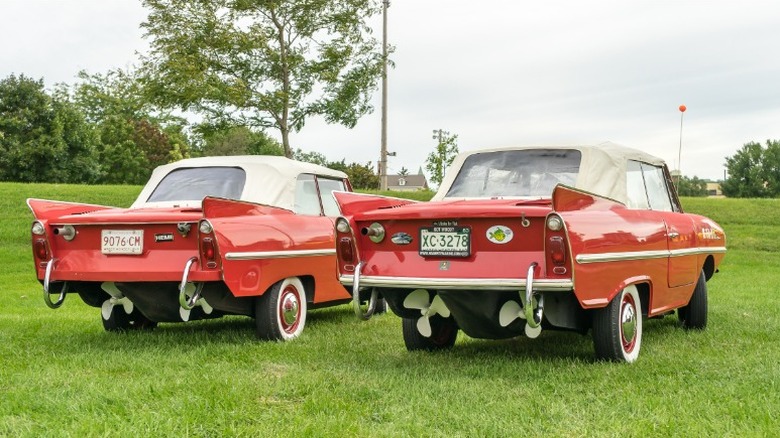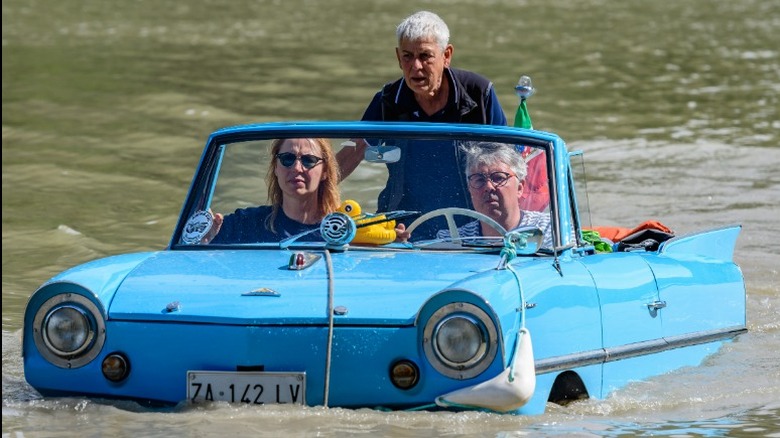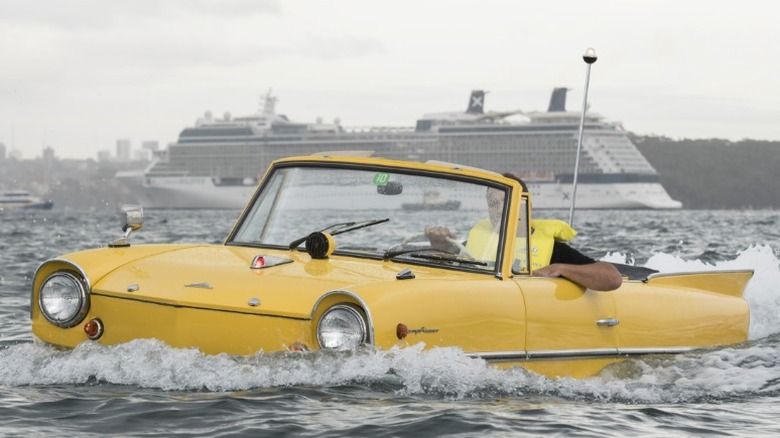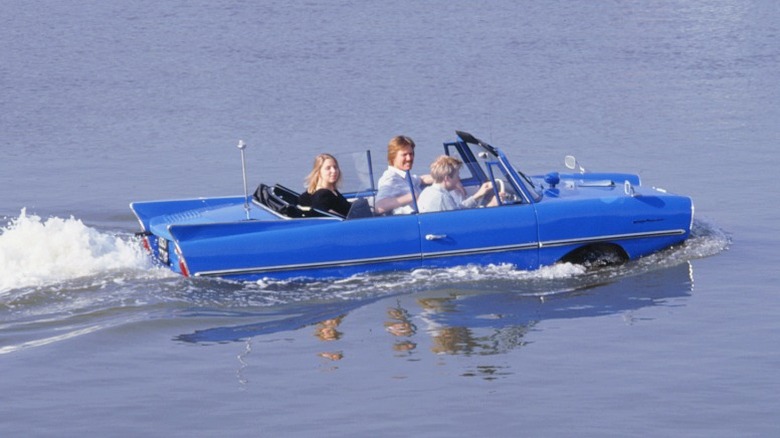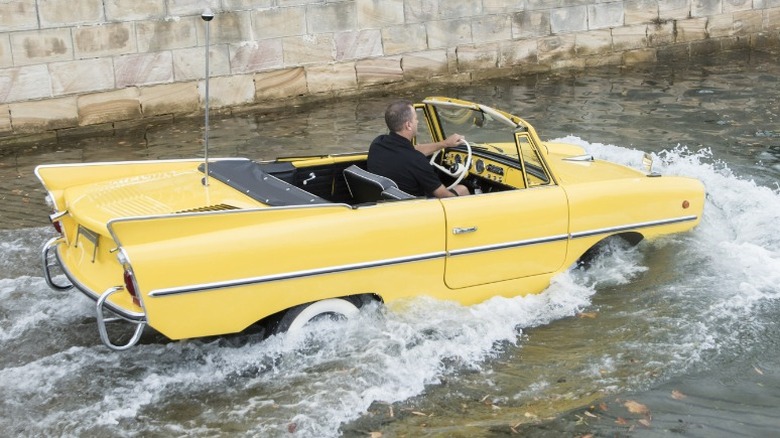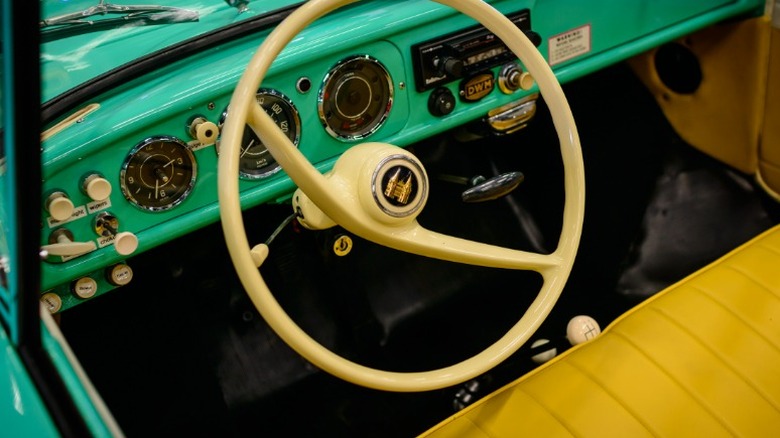Every Major Issue With The Amphicar
The versatility of an amphibious vehicle that travels on both land and water had its appeal in the 1960s when the German Quandt Group introduced the Amphicar car/boat, and today, the idea still has its allure. The design concept is ideal for owners seeking to use a single vehicle for two modes of transportation. One of the best representations of a dual-purpose vehicle was the James Bond Lotus Esprit S1 sports car (Via Motor Biscuit) that was converted into a submarine in the 1977 movie, "The Spy Who Loved Me." The British spy escaped his pursuing adversaries by driving off a pier into the water and disappearing below. Although the Amphicar has no submersible capabilities, the water-tight hull, propellers, and front tires allow it to float and maintain steerage on the surface of a lake or other relatively calm body of water.
Just under 4,000 Amphicars (via Silodrome) were sold from 1961 to 1968. Today, less than 600 seaworthy Amphicars remain (via Gothamist). Most are owned by enthusiasts enamored by the novelty of floating on the water in an automobile and willing to invest the time and money to maintain a vehicle that is neither an exceptional car nor a particularly remarkable boat. Time Magazine declared: "the Amphicar was both a lousy car and a lousy boat, but it certainly had its merits."
Here are some of the major issues with Amphicar ownership.
Celebrities who owned an Amphicar
The Amphicar has appeared in several Hollywood films including The Sandwich Man (1966), The President's Analyst (1967), and episode five of season four of The Avengers: "Castle De'ath" (1965). Country music singer Alan Jackson featured his car in the music video "That'd Be Alright," and Madonna used her Amphicar in the music video "Burning Up" (via Silodrome). Beatle John Lennon and comedian Dan Akroyd were also proud owners of the amphibian vehicle.
Two U.S. presidents: Jimmy Carter and Lyndon Johnson, were seen taking their Amphicars out for a cruise on the water. It was Johnson's favorite car, and he took great pleasure in surprising his unsuspecting guests by driving the car into a lake (via All Ears). While touring his ranch Johnson would steer the Amphicar towards the water yelling, "The brakes are out." The terrified passengers, expecting to swim to shore to avoid drowning, discovered the vehicle could float when Johnson sealed the doors and engaged propeller drive for a cruise around the lake. Johnson pulled the prank more than once on his surprised guests, including FBI Director J. Edgar Hoover.
Volkswagen Schwimmwagen
The origins of the Amphicar can be traced back to a German World War amphibious car, the Volkswagen Schwimmwagen (meaning floating car) designed by engineer Hans Trippel (via Allthatsinteresting). Based on Ferdinand Porsche's Kraft durch Freude Wagen (KdF) the VW Type 166, was designed for the German Wehrmacht. The bathtub shape, spare wheel mounted on the front, and a handrail on the sides gave the vehicle a distinctive look.
More compact and lighter than the Porsche 128, the Schwimmwagen, at 3.8 meters in length and weighing 900 kilograms, was equipped with an air-cooled 1.1-liter 4-cylinder producing a mere 25 hp (via Dyler). The engine was mated to a 5-speed gearbox consisting of four standard gears and one "crawl" gear. The power was sufficient to haul four fully armed soldiers to most destinations, albeit not with exceptional performance or speed. The "bathtub on wheels" reached a maximum speed of 90 km/h (54 mph). The rear-wheel-drive vehicle had the option to engage the front axle when required, and self-locking differentials enhanced handling over rough terrain.
The Schwimmwagen propelled through the water with a hinged propeller driven by a chain gear on the end of the crankshaft that extended from the engine housing while turning front wheels provided steerage. The amphibian reached a maximum speed of 12 km/h, and the 50-liter capacity fuel tank provided travel of 520 km on land. More than 15,000 Schwimmwagen units were made by mid-1944 and an estimated 190 still exist today.
Amphicar brief history
German industrial designer, Hans Trippel (1908 – 2001) was well-known for his design of the Mercedes-Benz 300 SL gull-wing doors (via Classic Motor Sports). Although he pursued a career as a racecar driver in 1934, he is best known for his development of amphibious motor vehicles, most notably the Amphicar and the Volkswagen Schwimmwagen that preceded it. Trippel's Amphicar design made significant improvements over the more primitive Schwimmwagen, refining the military amphibian to create a stylish civilian vehicle. For example, the Schwimmwagen's propeller required manually lowering it into position for a water crossing, while the Amphicar propellers remained in place, making the transition from land to water effortless.
The Quandt Group, headed by Harald Quandt (a business conglomerate that owned shares in BMW and Mercedes), manufactured the Amphicar at the company's Karlsruhe Augsburg AG (IWKA) industrial plants in Berlin and Lubeck (via Auto Evolution). Introduced in 1961 at the Geneva Salon, the first commercial model was named the 770: it reached 70 mph on land and 7 mph on the water. Most of the two-door, four-seater convertible Amphicars were exported to the U.S., selling for about $2,800 (just under $28,000 in today's dollars). Although the vehicle was not cheap (a 1961 VW Beetle had a list price of $1,655), it was a bargain for a dual-function car/boat (via How Stuff Works). Quandt manufactured 3,878 units during its brief run until 1968 when the U.S. Government implemented new EPA and DOT regulations. The Amphicar failed to meet the new emissions and safety standards and production was shut down. The Amphicar remains the only non-military amphibious passenger vehicle ever to be mass-produced (via Gothamist).
How the Amphicar works
The Amphicar is built in the shape of a pontoon, which provides the buoyancy needed to remain afloat. The water displacement by the hull exerts an upward force, which keeps the vehicle from sinking and maintains a dry passenger space. The upswept bow at the front of the vehicle is pointed and sharply cuts away below to a flat bottom. The wheels are mounted low on the body to provide the vehicle with plenty of ground clearance. A foldable top supported by a one-piece curved windshield gives the Amphicar a cabriolet style.
The Triumph Herald 1147 cubic centimeter engine is mounted in the rear and mates to a transmission boasting Porsche components. The drivetrain sends power to the rear wheels while on land and to twin propellers mounted under the rear bumper while floating. (via Classic Motor Sports).
On the water, the land-operated throttle controls the speed of the propellers via a special transfer case. The land transmission can be placed in "neutral" or engaged to simultaneously drive both the wheels and the props, providing a smooth water entrance and exit. Once underway, the front wheels act as rudders (via Auto Evolution). The system has limited functionality and at low speeds when the steerage is minimal or nonexistent, changing the Amphicar's direction on the water was a challenge and never done in a hurry. Although the brakes still function in the water, they do nothing to slow down the vehicle. Like most boats, reversing the props works best.
Limited performance on both land and sea
In a 1960s advertising campaign, the slogan read: "Amphicar-the sportscar that swims." However, the car/boat accelerated to 60 mph in a lackluster 21.7 seconds, reached a top speed of 70 mph on land, and traveled at a maximum speed of 7 mph in water. The Quandt Group selected a British Triumph Herald 1200 1147 cc (69 cubic inches) water-cooled engine to power the Amphicar for its respectable performance, lightweight, cool running, and reliability. The powerplant produced (via Automobile Catalog) a maximum of 43 hp and 61 lb-ft of torque. The company upgraded the engine on later models to 1296 cc (79 cubic inches) and 1493 cc (91 cubic inches) producing up to 75 bhp.
For exiting the water on a typical boat ramp, the vehicle's ample ground clearance, approach, and departure angles, along with the four-speed gear ratios enabled the Amplicar to climb a thirty-nine percent gradient. A typical exit required approaching the boat ramp with both propellers operating and the first gear engaged. While the brakes serve no purpose while in the water, they are fitted with special liners for improved wet operation when the vehicle exits.
Classic Motor Sports wrote: "Driving one is much like driving any other small, European sedan from the late '50s or early '60s. The steering wheel is big, the brakes are iffy, the handling is soft, and the 43-horsepower engine has a hard time getting the car out of its own way. In other words, it's terribly fun."
Amphicar's weight effect on performance
The Amphicar weighs more than 2400 pounds, which exceeds most compact cars of the 1960s era. The Ford Anglia tipped the scales at 800 pounds less. The Amphicar produces slightly more power to compensate for the extra weight (via Automobile Catalog). The Anglia generates 39 hp and 51 lb-ft of torque while the Amphicar produces 43 hp and 61 lb-ft of torque. However, the vehicle was equipped with narrow tires and sat almost 10 inches off the ground, resulting in poor road handling performance.
The extra weight of the Amphicar comes from the heavy-duty steel used in constructing the body/hull and the additional equipment needed to keep the seawater out and the cabin dry. Unique to the amphibious vehicle are the sealed axle shafts in the rear, twin propellers, and a bilge pump. Both side doors were equipped with an extra handle and mechanism to close the doors tightly against rubber seals and prevent water from entering the cabin.
The substantial weight of the Amphicar means the vehicle must displace a significant amount of water to float: At 62.4 pounds/cubic foot, the 2400-pound vehicle displaces almost 40 cubic feet of water (via Classic Motor Sports). The vehicle has an ample draft (the distance between the waterline and the deepest point of the boat) of at least two feet. The portion of the vehicle that remains above the water level provides only a minimum of protection against even the smallest waves.
Amphicar water leaks
When the Quandt Group built the Amphicar, the company equipped the vehicle with a bilge pump knowing that some water would inevitably enter the cabin. Splashing water over the Amphicar's sides is unavoidable while keeping the vehicle from leaking past door seals presented a significant challenge. According to How Stuff Works: "the Amphicar's body/hull employs a box-section steel sub-frame for added torsional strength, made up of parallel longitudinal members and five cross-members. Strong mountings are used for the fully independent suspension, and all sub-frame components and the steel body panels are arc-welded."
Trippel chose steel over fiberglass for the body, but he used unusually heavy-duty material: Side panels are .028 inches, hull bottom panels are .049 inches, and wheel arches are .039 inches thick. While steel gives the vehicle better performance on land than a fiberglass body, it makes the vehicle susceptible to rust.
The Amphicar doors provide the biggest risk of water leakage. The doors are equipped with double hinges with rubber plugs, and a seal on each door mates with one on the door frame. In addition to the normal door latch, a second lock compresses the seals together and prevents the door from being opened accidentally during water travel. To keep the Amphicar watertight, the vehicle should be inspected frequently at the joints and panel seams. The company recommends rinsing the hull, suspension, and nautical propulsion components with fresh water after use in salt water and verifying the integrity of all seals. Proper drying of the Amphicar and emptying the bilge pump after each use will prolong its life (via Classic Motor Sports).
A water launch is always unsettling
Driving a vehicle that runs like a car on the road into a large body of water can be daunting, and for many passengers, the "sinking feeling" is enough to discourage them from taking the plunge. Most Amphicar owners become accustomed to the launch and select the appropriate ramp and vehicle speed to make a safe entry without much water splashing over the sides or bogging the vehicle on a soft bottom. However, while the manufacturer recommended a slow descent, some owners enjoy the challenge of entering at up to 50 mph.
For the timid, the boathouse on Lake Buena Vista at Disney Springs Orlando offers an opportunity to experience the dual modes of transportation without purchasing an Amphicar. The Boathouse is the only location in the world offering a Captain's Guided Tour in the vintage amphibian vehicle. Passengers can be assured that the driver has plenty of experience and knows how to navigate the waters without getting (too) wet.
Replacement parts are expensive and registration a challenge
When the Quant group began production of the Amphicar, the company had intended to manufacture many more than the 3,878 units it delivered. As a result, there are plenty of spare parts available for collectors who need to refurbish their vehicles. When U.S. EPA and DOT regulations went into effect in 1968, exports ceased, and the Berlin factory shut down. Hugh's Gordon Imports, California, purchased the remaining inventory of unused parts and became the primary source of Amphicar spares. In addition, when original parts are no longer available substitute parts are available from other aftermarket suppliers (via Gothamist).
Buyers who import an Amphicar have the additional expense of upgrading it to meet U.S. emissions standards. Furthermore, some owners have reported difficulties registering their vehicles as boats even if Coast Guard regulations are met with navigation lights and other boat safety equipment. Replacement parts are expensive, and a rising demand for the unique vehicle help contribute to the rising resale value.
Today, the Amphicar is a rare, highly valued vehicle, sought after by enthusiasts and car collectors. They are seldom seen at auctions, but when an Amphicar in good condition appears, the price reflects the vehicle's demand. While the Amphicar 770 sold for $2,800 in 1961, a typical resale price today is about $75,000 (via Classic Trader). In recent years, the highest auction sales price for an Amphicar was $161,700 (via Classic).
